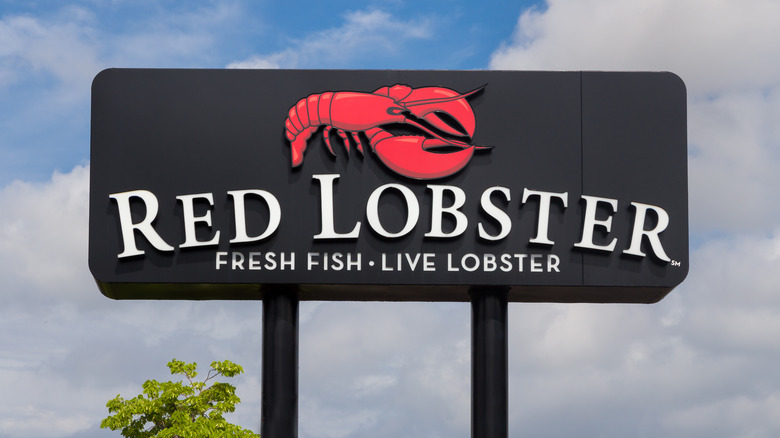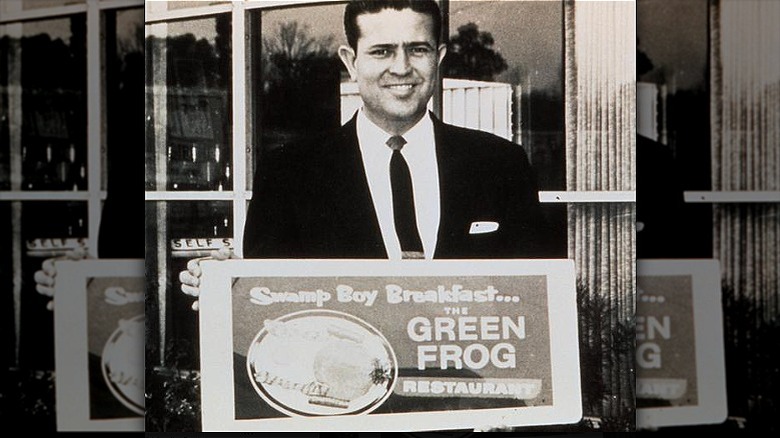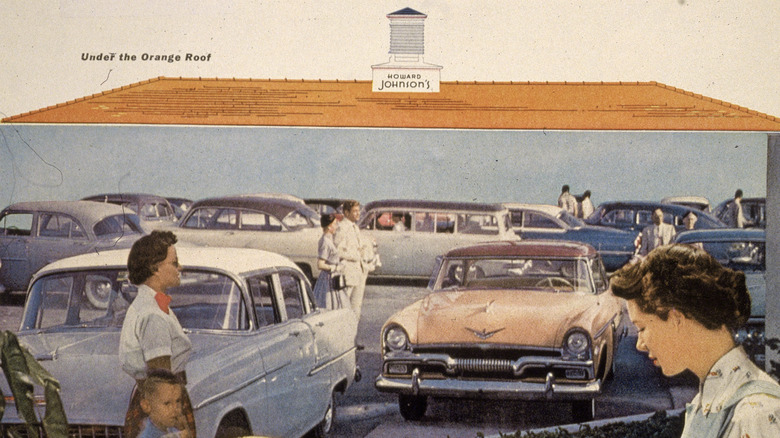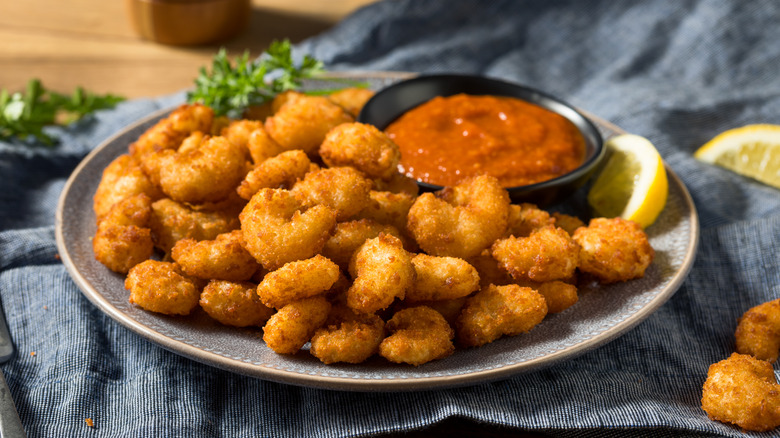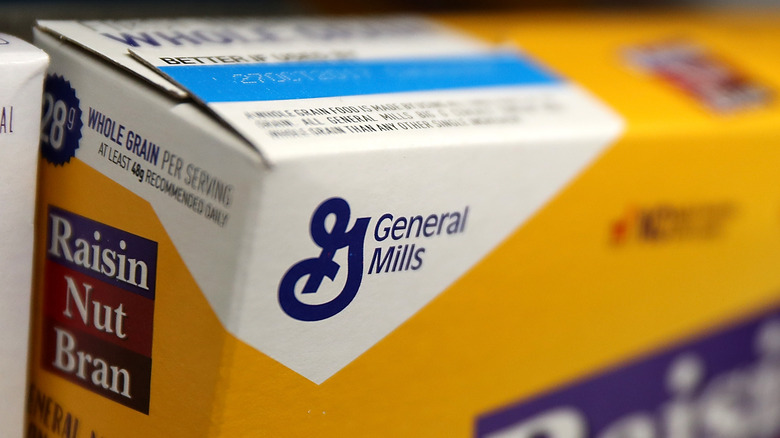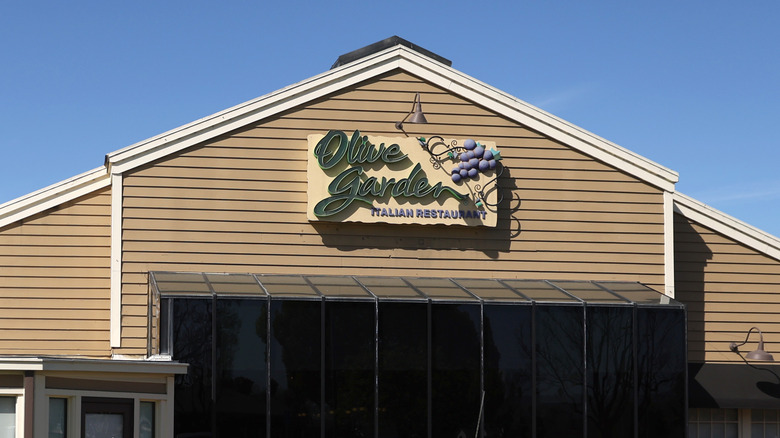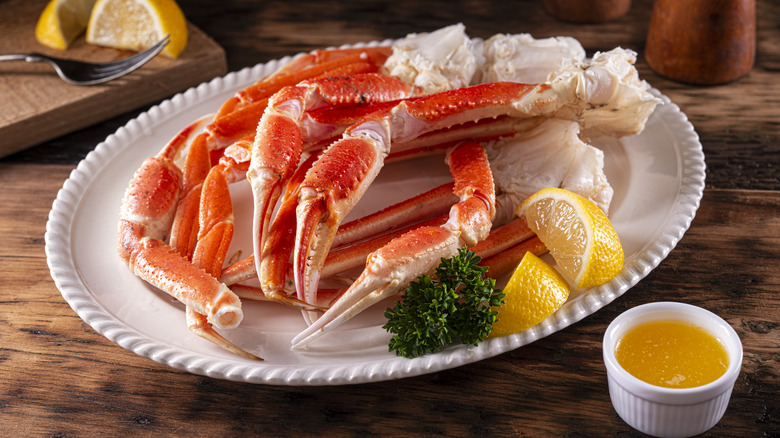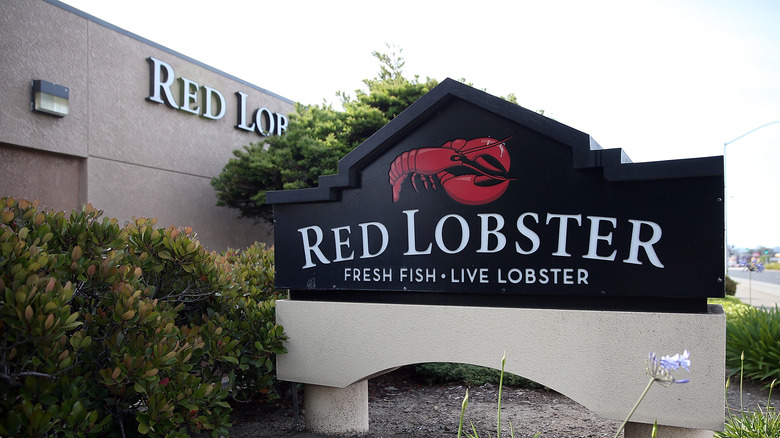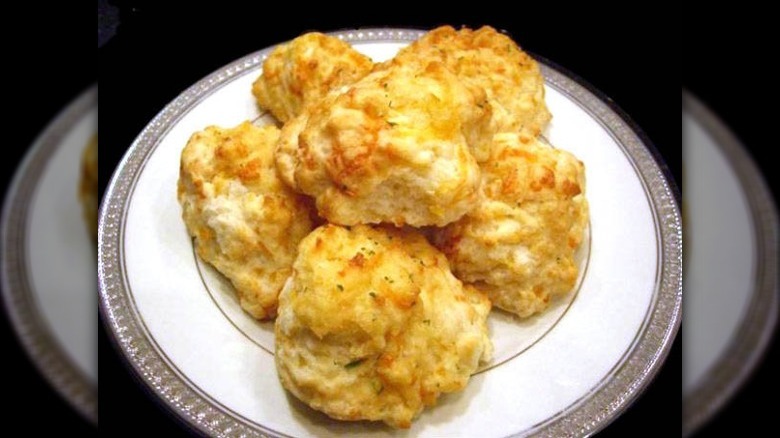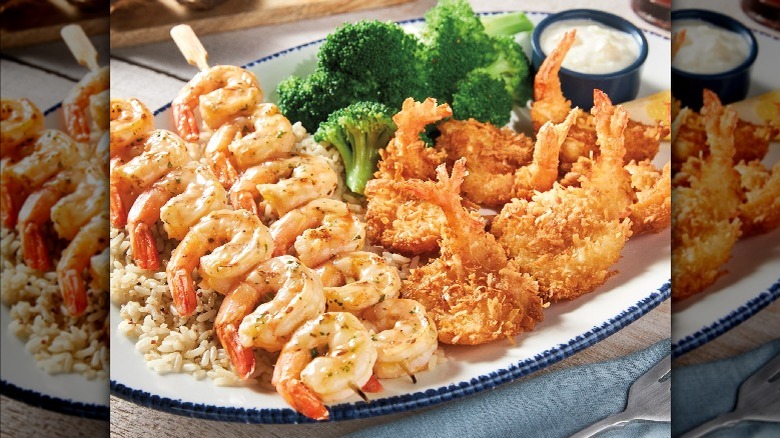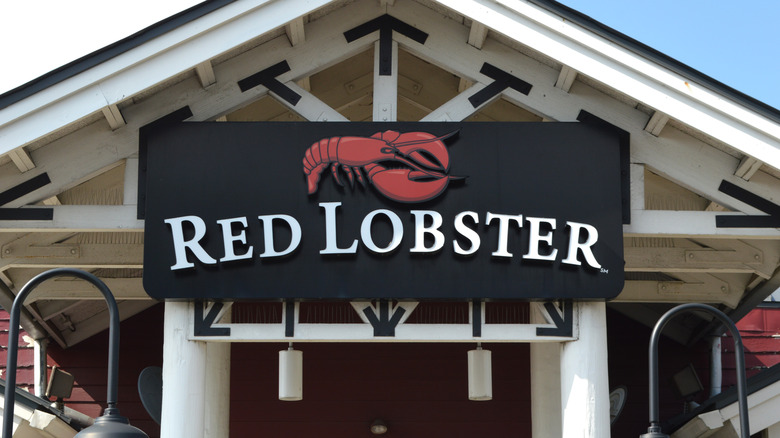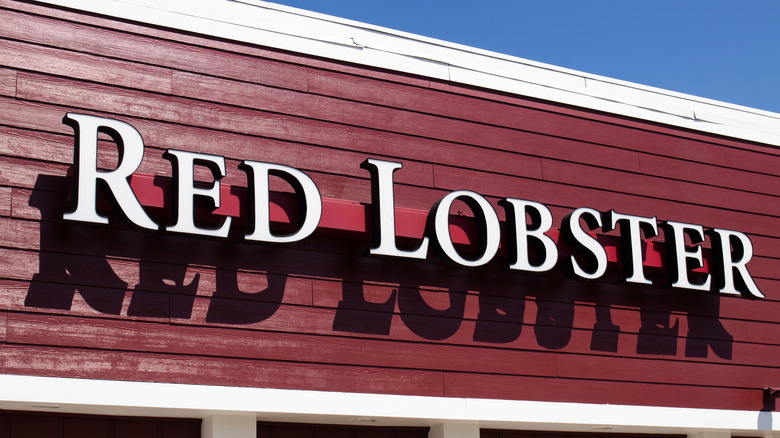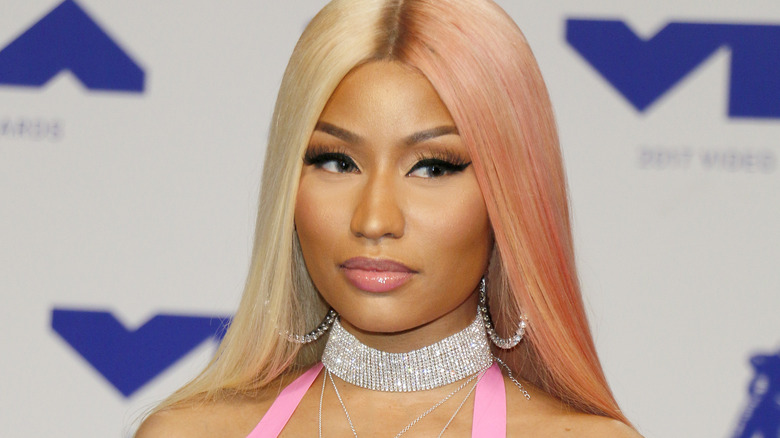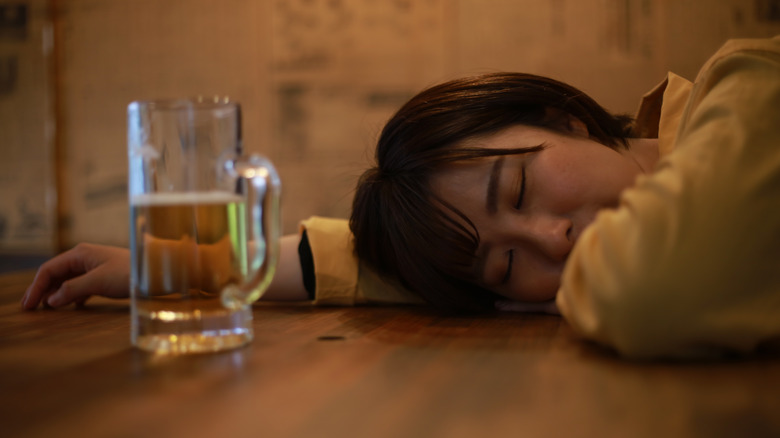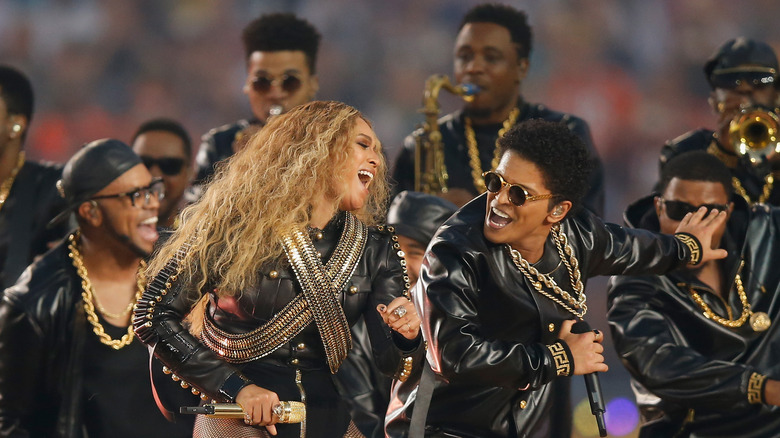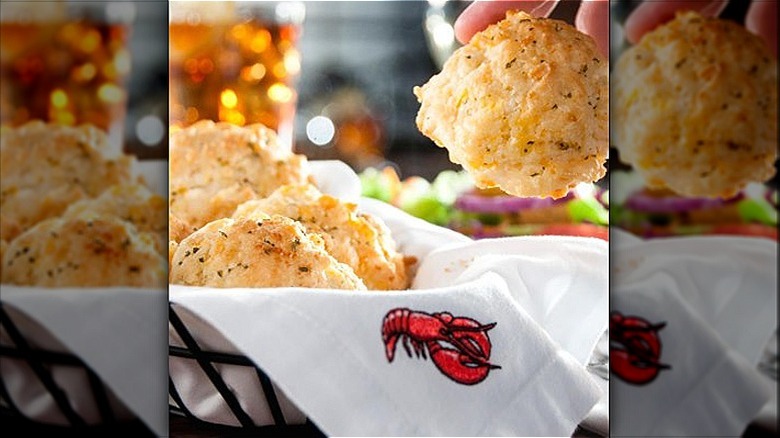18 Fascinating Facts About Red Lobster
Whether you are there for Lobsterfest, a Signature Feast, or to see how many Cheddar Bay Biscuits you can down in one sitting, chances are you have dined at a Red Lobster restaurant at least once in your life. Not only has it been around for a long time, but it is also one of the most prolific restaurant chains in the U.S. Indeed, there are currently 662 Red Lobster locations in the country, spread across 542 cities in 44 states and territories. Florida boasts the most Red Lobster stores at 60 locations, with Texas and California close behind, at 55 and 43, respectively.
Its appeal is more than just abundant and affordable fish and seafood. Clever marketing, good business practices, and a commitment to sustainability have kept Red Lobster competitive throughout the ups and downs of the restaurant industry. Its core values of supporting food, families, and oceans have also set it apart — the chain consistently donates resources to charities in local communities and abroad. As such, we wanted to delve further into the fascinating history and the legacy that has led Red Lobster to "Sea Food Differently" since 1968.
1. Bill Darden began his restaurant empire at the age of 19
In 1938, 19-year-old Bill Darden entered the restaurant business by purchasing a 25-seat eatery named The Green Frog in Waycross, Georgia. This lunch counter offered its customers "Service with a Hop" and leaned into Darden's belief that equitable treatment of all of his guests was critical to the success of his venture. His instincts were spot on, giving him the financial stability to slowly expand his empire by purchasing several other businesses across Georgia.
In 1963, Darden and his investing partner Charley Woodsby took a leap of faith, purchasing a well-loved seafood restaurant in Orlando, Florida, called Gary's Duck Inn. Gary's Duck Inn was the breeding ground Darden needed to eventually take the reins and open his restaurant in Lakeland, Florida, in 1968 — Red Lobster. His mission was to make fresh seafood available to people of any race, ethnicity, or socio-economic status, no matter how far away they lived from the ocean. By all measurable statistics, his mission succeeded, making Darden something of a legend in the restaurant industry.
2. It is inextricably tied to Howard Johnson's
One of the many ventures Bill Darden made along his way to opening his first Red Lobster was to purchase several Howard Johnson restaurants and motels. Howard Johnson was the first restaurant chain of its type and was the most successful during the 1950s and 1960s. "Hojo's" success was built on the genius strategy of constructing roadside motels across the U.S. highway system. It also capitalized upon brand recognition represented by its unmistakable bright orange roof, which could often be seen from a mile away. Howard Johnson's menu consisted primarily of popular comfort foods at an affordable price aimed directly at middle-class families. There was also a concerted effort to accommodate children with an extensive menu just for kids.
Without much advertising necessary, name recognition led to an empire that lasted well into the late 1970s. Darden absorbed what worked for Howard Johnson and built upon it when he branched out on his own.
3. Red Lobster is responsible for popcorn shrimp
In 1974, Red Lobster introduced its legendary popcorn shrimp to the menu. The bite-sized battered and deep-fried delights were an ingenious invention capitalizing on the increasing popularity of shrimp in the U.S. during the 1970s. CEO of Darden Restaurants, Inc. Joe Lee noted to the Orlando Business Journal in 1998: "We ... invented popcorn shrimp and introduced snow crab and calamari to middle America." This move solidified the mainstream consumption of seafood from coast to coast.
While numerous other seafood restaurants have attempted to create variations on this dish, none have been quite as successful in turning it into such a sensation. Popcorn shrimp remains one of the most popular items on the Red Lobster menu, with reviewers commenting on how much they love it. However, we do not recommend making it a frequent treat — one side order of popcorn shrimp packs a nutritional punch of 430 calories and a whopping 1,860 milligrams of sodium, almost the entire recommended daily value of 2,300 milligrams of sodium.
4. It was owned by General Mills for 25 years
Within two years of opening, Red Lobster caught the attention of food magnate General Mills. By that point, three Red Lobster locations were open in Florida; the restaurants were thriving but not necessarily making enough money for Red Lobster to really expand. Since one ninth of General Mills' revenue came from the sale of fish, the company saw an opportunity for expansion and purchased the chain in 1970. It established a corporate headquarters for Red Lobster in Orlando, Florida, and put Bill Darden in charge.
Under the umbrella of General Mills, the Red Lobster business model changed. It went from an affordable seafood joint serving predominantly fried, previously frozen fish into a mid-range seafood restaurant. It was the pinnacle of quality and efficiency, with locations across the country and its seafood purchasing department capable of sourcing the finest fish and seafood worldwide.
By 1982, Red Lobster had grown into the biggest chain of sit-down restaurants in the U.S., with profits to match. The company continued to be a part of the General Mills family until 1995, when Darden Restaurants, Inc. emerged. Red Lobster continued to grow and reinvent itself under the direction of Darden Restaurants, Inc., returning to its roots and becoming more of a casual dining experience.
5. Its look is based on Bar Harbor, Maine
In 2011, Red Lobster announced a massive remodel of its locations based on extensive research and customer feedback. The inspiration for this remodel was the quaint seaside village of Bar Harbor, Maine. Distinct features integrated into the exterior design included a stone tower, Adirondack chairs, ship lanterns, and window signage corresponding to the types of seafood dishes served. Interior features continued with the nautical theme, utilizing warm colors, wood paneling, signal flags, appropriately oceanic artwork, and softer lighting.
Red Lobster's redesign did not end there. The logo underwent an upgrade, with a sleeker, more contemporary lobster and the words "Fresh Fish. Live Lobster" added. This upgrade also included the introduction of several new dishes to the menu, each harkening to the regional diversity of Red Lobster locations. Items like Maple-Glazed Salmon or Shrimp, New England Lobster Rolls, Cedar Plank Salmon, and Parmesan-Crusted Tilapia were all designed for sale at affordable prices.
6. Red Lobster has a special tie to Olive Garden
In conjunction with the ever-expanding Red Lobster empire that General Mills launched, the company set its sights on creating more lucrative ventures. One of these was Olive Garden. The first Olive Garden opened in Orlando, Florida, in 1982. The menu was not as refined as today, with options ranging from some Italian specialty dishes to generic meat and seafood offerings. By 1989, Olive Garden had become one of the fastest-growing restaurant chains in the country, boasting 145 locations.
When Darden Restaurants, Inc. came about in 1995, Olive Garden transitioned along with Red Lobster. The two became bedrocks of the organization, representing a majority of its assets and profits throughout the 1990s and into the early 2000s. Olive Garden remains one of the premier restaurant chains under the umbrella of Darden Restaurants, Inc. today, with 897 locations in 52 states and territories.
7. Endless snow crab almost sank the empire
In 2003, a cataclysmic event occurred, causing Red Lobster to lose $3.3 million in seven weeks — its Endless Crab promotion. The method behind the madness that Red Lobster executives were banking on was that Americans wouldn't consume more than the restaurant's break-even point, which, at approximately $20 a plate, was about two helpings. But the eagerness of those seeking to have their fill of snow crabs was grossly underestimated — consumers regularly piled away pounds and pounds of the valuable commodity.
The problem had to do with supply and demand. At the time, the government strictly regulated quotas for snow crab harvesting because of the crabs' dwindling numbers. This shortage pushed per-pound crab costs up dramatically, something that had been a trend for a couple of years and that Red Lobster marketing gurus should have taken into account. Yet, despite a market price of $5 per pound for crab, they didn't, causing both the company and individual stores to lose tons of cash.
And the problem went deeper. Customers shelling endless crab took forever to dine, meaning servers were stretched thin, and turnover times were exceedingly slow. What Red Lobster might have recouped in sales, it lost due to consumers parking at tables for hours. The failure almost broke the bank and taught the company a valuable lesson in consumer dynamics.
8. It is no longer a part of the Darden family
On July 28, 2014, Red Lobster announced its acquisition by San Francisco private equity firm Golden Gate Capital for $2.1 billion. The firm, which also owned California Pizza Kitchen and Bob Evans restaurant, swooped in after sales had floundered under the management of Darden Restaurants, Inc. In 2016, global seafood supplier Thai Union Group put up $575 million to obtain a 25% stake in Red Lobster. Amid concerns over the restaurant industry and seafood supply chain challenges during the pandemic, Golden Gate decided to sell its remaining stakes to Thai Union in August 2020.
While many predicted Red Lobster wouldn't fare well in a post-pandemic world, it has continued to do what it has always done best — evolve with the times. It now offers a robust touchless delivery, a contactless curbside pickup program, and budget-friendly Family Feast options. Its future outlook appears solid.
9. Get freebies by joining its Fresh Catch Club
Loyalty rewards clubs aren't a new thing. Many corporations offer regular consumers perks for being repeat customers, and Red Lobster is no different. With its My Red Lobster Rewards app, customers can "Earn. Eat. Repeat." It's simple — customers earn one point for every dollar spent at any Red Lobster in the country. And once they accumulate 125 points, they can get a free meal. As a bonus for signing up, customers receive 75 points to start for free, getting them well on their way to cashing in.
Guests earn additional incentives as they use the app by completing their profile, which will graduate them to Gold Member status, and by accumulating 300 points annually, which will grant them Platinum Member status. Free birthday meals, coupons, quarterly special catch rewards, double points on to-go orders, insider information, and more make this a great rewards program. If you love seafood and regularly dine at a Red Lobster, you'd be remiss in not joining. The app is available on both iPhone and Android.
10. Its Cheddar Bay Biscuits were a late addition
Few restaurant menu items have the cult-like following that the Cheddar Bay Biscuits of Red Lobster do. The Cheddar Bay Biscuit has a Facebook page with a healthy following of around 900,000 super fans. To say that people love these cheesy, garlicky biscuits would be an understatement. Many visit Red Lobster solely to get Cheddar Bay Biscuits when they order seafood, to the tune of roughly 1 million biscuits made daily, baked every 15 minutes.
Ironically, these buns of gold were late to the party, only becoming a part of the Red Lobster menu in 1988, 20 years after its first location opened. And, if you can't get enough Cheddar Bay Biscuits during your meal, you can even buy a mix at the grocery store to make your own at home. Alternatively, you can order them by the dozen or half-dozen to go directly from your local Red Lobster. Cheddar Bay Biscuits are big business, and they are here to stay.
11. The Endless Shrimp really are endless
We already know that consumers love a bargain, particularly one that promises endless quantities of anything. While Endless Crab was a decidedly poor business decision for Red Lobster, its Endless Shrimp promotion is genius. Because of the wholesale price at which Red Lobster can obtain them, one would have to eat a huge number of shrimp to push the boundaries of the restaurant's break-even point — around 100. And even then, when you add the relative unlikelihood of this happening regularly together with the fact that guests typically order other items, like alcoholic beverages, chances are that even if a customer eats more than 100 shrimp, Red Lobster will still come out ahead.
But are they endless? In the summer of 2015, two Insider reporters decided to find out. They cleared their schedule for the day to do nothing but eat shrimp at the Red Lobster in New York City's Times Square. The two reporters consumed a whopping 305 shrimp combined over eight hours and were never turned away by management. As time went on, they were made aware of off-menu items that they could order to change things up a bit, like Coconut Shrimp and the belly bomb Shrimp Linguine Alfredo. In the case of Red Lobster's Endless Shrimp, you more than get your money's worth.
12. Red Lobster is committed to sustainability
Considering that Red Lobster purchases more seafood than any other seafood restaurant in the world, one might wonder about the quality of its food and if it is sustainable. From the beginning, Red Lobster committed to providing "Seafood with Standards," a pillar of purchasing practices geared toward traceability, sustainability, and responsibility. It was a founding member of the Global Aquaculture Alliance, today known as Global Seafood Assurances, which is a non-governmental agency responsible for developing and implementing the Best Aquaculture Practices certification. Red Lobster is also on the board of directors for the National Fisheries Institute.
In 2018, Red Lobster teamed up with the Monterey Bay Aquarium's Seafood Watch program, which developed an app geared toward steering consumers toward more sustainable choices when ordering or purchasing seafood. But look no further than Red Lobster's website to gain confidence that you are making a sound consumer decision when dining there. The company makes information on how and where it sources its lobster, crab, shrimp, and fish freely available.
13. It's home to one of the most unhealthy meals of all time
In 2015, the Center for Science in the Public Interest set out to determine the most unhealthy chain restaurant meals. The results were dubbed the Xtreme Eating Awards (via CNBC), and the winner was a Red Lobster "Create Your Own Combination" dish. The dish, featuring Parrot Isle Jumbo Coconut Shrimp, Walt's Favorite Shrimp, and Shrimp Linguine Alfredo plus Caesar salad, french fries, and a Cheddar Bay Biscuit, came in at 2,710 calories and a heart-stopping 6,530 milligrams of sodium. If you wash this down with a Lobsterita, Red Lobster's signature margarita which itself contains 890 calories, the meal might top 3,600 calories in one sitting.
Red Lobster's marketing quickly responded, pointing out that this was just one of many possible combinations a consumer could order, many of which would be far healthier. However, the awards highlighted that this type of oversized portion loaded with fat and sodium was becoming the norm, rather than the exception, at restaurants across the country. If nothing else, it points out the degree to which consumers might want to do a little math when deciding what to order. Red Lobster has taken the guesswork out of this by providing a "Nutrition and Allergy Portal" on its website, where diners can plug in their potential choices and assess whether they are healthy as well as safe to consume with a particular food allergy.
14. If you want to make it big, work at Red Lobster
It is no secret that several high-profile celebrities once worked at Red Lobster. In one of his comedy specials, Chris Rock told the audience that he worked in the back of the house of a Red Lobster. While there, he would "scrape shrimp in the garbage cans and then load up the dishwasher" (via YouTube), doing a job that didn't provide much opportunity for upward mobility. Anna Nicole Smith also purportedly worked at the restaurant chain before becoming Playmate of the Year at Playboy.
But perhaps the most notorious Red Lobster employee-turned-superstar is rapper Nicki Minaj, who was allegedly repeatedly fired from numerous New York Red Lobster locations due to her dubious customer service skills. From losing a fingernail in a customer's salad to following a customer out to the parking lot and flipping them the bird for stealing her pen, she challenged the limits of what was considered acceptable decorum for a server at a restaurant.
15. Nobody went into a food coma
In 2013, Red Lobster was the butt of a not-so-kind joke courtesy of the friends of an Arkansas native who was allegedly admitted to a hospital and went into a coma due to consuming too many Cheddar Bay Biscuits at a Little Rock location. The story claimed that he had eaten 413 biscuits, which would be roughly 62,000 calories, an unlikely feat.
Hard to believe or not, publications across the globe glommed onto the story, spreading it far and wide and creating a media frenzy that put Red Lobster in the proverbial hot biscuit seat. Thankfully the man at the center of the prank cleared the air by posting on Twitter that the story was fake and that he was fine, but not before the story had gone viral. While media outlets quickly deleted the false accusations, several outlets, including British publications the Sun, Daily Mail, and Mirror, never apologized for publishing the story in error.
16. Red Lobster was sued for over-serving alcohol
According to a lawsuit filed against a Houston-area Red Lobster in 2017, the restaurant chain was responsible for an older woman falling in the parking lot after she consumed too much alcohol. The 82-year-old woman reportedly broke her arm and hip and was taken to a local hospital, where her blood alcohol level was tested at 0.31, nearly four times the legal limit. She spent six days in the hospital undergoing medical treatment, including a hip replacement.
A resident of a local senior living center, this woman frequently visited Red Lobster, often returning home inebriated. These circumstances prompted her daughter to allegedly have repeated conversations with management at the location to address its alcohol service policies. A spokesperson for Red Lobster stated that "Red Lobster has strict policies and procedures when it comes to the service of alcohol. We take these guidelines very seriously and ensure our team members are properly trained and follow these procedures when serving alcohol" (via Law & Crime). Although we conducted follow-up searches, we could not determine the outcome of this lawsuit.
17. Beyonce helped business boom
The Super Bowl is one of the most effective marketing platforms out there. Corporations typically spend obscene amounts of money buying commercial time during the big game. In 2016, Red Lobster obtained a bit of free marketing courtesy of one of the greatest superstars in the music industry, Beyoncé. In her halftime performance of the new song "Formation," she included a line about Red Lobster, which purportedly resulted in a 33% increase in sales at the restaurant chain immediately following the show.
A spokesperson for Red Lobster noted that the brand was mentioned 42,000 times on Twitter within an hour of the performance, a first for the restaurant chain. However, the chain did experience some backlash after a rather uncreative response on Twitter reading: "'Cheddar Bey Biscuits' has a nice ring to it, don't you think?" Perhaps that tweet was even more cheesy than the legendary Cheddar Bay Biscuits are?
18. You always get the wrong number of biscuits
If you have ever dined at a Red Lobster, you may have noticed that the chain never gives you the right number of Cheddar Bay Biscuits. Specifically, there's one more biscuit than there are diners at the table. It's an oddity, but it's one that isn't unique to Red Lobster. Many have noted this at other establishments, like Olive Garden with its breadsticks. A columnist for the San Diego Reader suggested that restaurants do this as a matter of etiquette, noting, "An odd number of rolls allows an even number of people to take one and still gives the last roll-taker a choice."
In 2016, a self-identified employee of Red Lobster stated an archived Reddit thread that the extra biscuit is an unofficial policy at the restaurant chain — "We bring one biscuit for every person at the table, plus an additional biscuit for the table." Whatever the reason is hardly matters because you can always ask for more Cheddar Bay Biscuits and get a few extras to take home with you. This way, one can always get their fill of these somewhat addictive delights.
